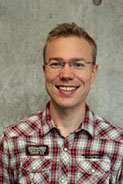The Digital Classroom
Group eye-tracking in the classroom of the future
The digital classroom is a unique facility enabling the simultaneous recording of eye-movements of up to 16 students in a classroom as well as their teacher. Such recordings provide information about where people look on a computer screen, for how long and in which order. This facility also makes it possible to show this information in real-time to others.
Amongst many topics, the facility is suited for studies of the effect of social presence on cognitive and learning processes, the study of collaboration and competition behavior from the view of both social and cognitive psychology, and the development and study of new forms of technology-enabled teaching and learning.
The digital classroom was funded by the Knut and Alice Wallenberg Foundation, the Lund University Committee for Research Infrastructure the Marcus and Amalia Wallenberg Foundation, and a donation from the LMK foundation.
Diederick C. Niehorster

Diederick is a researcher and a research engineer with the Humanities Lab, Lund University. He is interested in discovering novel ways in which eye tracking technology can augment learning in a classroom setting, through shared gaze displays that support communication and collaboration between participants. He develops and uses novel multi-observer eye tracking paradigms and is working on building the Lund University’s Digital Classroom into a proving ground for the eye tracking and augmented reality supported classroom of the future.
Marcus Nyström

Marcus Nyström is an Associate Professor of Ergonomics (2015) and has a PhD in Information Theory (2008). His research interests include visual perception and cognition, learning, eye movements, and eye tracking - all with an interdisciplinary focus. Of particular interest are questions that concern why we move our eyes to certain locations in the environment, and how this is modulated by factors such as physical properties of the environment, expertise, disorders, and cognitive state. He is also interested in how the research methods and instrumentation can influence the outcome of a study, and work on developing techniques and methods to standardize and improve the validity of eye movement data.
Halszka Jarodzka
Assistant Professor at the Open University of the Netherlands and Visting Scholar at Lund University (20%). Specialized in the use of eye tracking in Educational Science. Co-author of the widely cited methodology book on eye tracking (Holmqvist et al., 2011, Oxford University Press).
.
* Tim Cornelissen. Scene Grammar Lab, Department of Psychology, Goethe University Frankfurt, Frankfurt, Germany. Sept - Dec 2016.
* Edwin Dalmaijer. Department of Experimental Psychology, University of Oxford, Oxford, UK. Mar - Apr 2017.
* Ignace Hooge. Experimental Psychology, Utrecht University, Utrecht, The Netherlands. Yearly for two months.
Workshop
In October 2016 we (Holmqvist, K., Jarodzka, H., & Niehorster, D.C.) organized a colloquium on multiple eye tracker classrooms. We invited 21 international researchers who are interested in or are already working with multiple eye tracker set-ups, similar to Lund’s digital classroom, to present their research and discuss research agendas over three days.
Keynotes
- Jarodzka, H. (April, 2017). Keeping an eye on the classroom: How eye tracking helps us to understand and to support teachers and pupil. 5th Polish Eye Tracking Conference. Lublin, Poland.
- Jarodzka, H. (2016, June). Eye tracking in educational science. Keynote at the 28th Scandinavian Workshop on Eye Tracking Research, Turku, Finland.
- Jarodzka, H. (2016, April). Eye tracking in educational science. Keynote at the 4th Polish Conference on Eye Tracking, Warsaw, Poland.
Articles
- Jarodzka, H., Holmqvist, K., & Gruber, H. (2017). Eye tracking in Educational Science: Theoretical frameworks and research agendas. Journal of Eye Movement Research, 10(1), 1-18. http://dx.doi.org/10.16910/jemr.10.1.3
- Oliva, M., Niehorster, D.C., Jarodzka, H., & Holmqvist, K. (2017). Influence of coactors on saccadic and manual responses. i-Perception, 8(1). http://journals.sagepub.com/doi/abs/10.1177/2041669517692814
- Niehorster, D. C., Cornelissen, T., Holmqvist, K. & Hooge, I. (2019). Searching with and against each other: Spatiotemporal coordination of visual search behavior in collaborative and competitive settings. Attention, Perception & Psychophysics 81(3), 666-683. http://dx.doi.org/10.3758/s13414-018-01640-0
- Nyström, M., Niehorster, D. C., Cornelissen, T. & Garde, H. (2016). Real-time sharing of gaze data between multiple eye trackers : evaluation, tools, and advice. Behavior Research Methods. http://dx.doi.org/10.3758/s13428-016-0806-1
- Špakov, O., Niehorster, D., Istance, H., Räihä, K.-J. & Siirtola, H. (2019). Two-Way Gaze Sharing in Remote Teaching. In Lamas, D., Loizides, F., Nacke, L., Petrie, H., Winckler, M. & Zaphiris, P. (Eds.) Lecture Notes in Computer Science, Human-Computer Interaction – INTERACT 2019 : 17th IFIP TC 13 International Conference, Paphos, Cyprus, September 2–6, 2019, Proceedings (pp. 242-251), 11747. Springer. http://dx.doi.org/10.1007/978-3-030-29384-0_16
Presentations
- Dalmaijer, E.S., Niehorster, D.C., Holmqvist, K., & Husain, M. (2017, August). Joint visual working memory through implicit collaboration. Presented at ECEM 2017.
- Niehorster, D.C., Cornelissen, T., Hooge, I.T.C., & Holmqvist, K. (2017, August). Searching with and against each other. Presented at ECEM 2017.
- Räihä, K.-J., Spakov, O., Istance, H. & Niehorster, D.C. (2017, August). Gaze-assisted remote communication between teacher and students. Presented at ECEM 2017.
- Niehorster, D.C., Cornelissen, T., Hooge, I.T.C., & Holmqvist, K. (2017, May). Searching with and against each other. Presented at VSS 2017.
- Oliva, M., Niehorster, D.C., Wallin, A., Balkenius, C., Holmqvist, K., & Jarodzka, H. (2016, August). The social brain goes to school: Eye movements, instructional design and the classroom effect. EARLI SIG 6&7, Dijon, France.
- Oliva, M., Niehorster, D.C., Jarodzka, H., & Holmqvist, K. (2016, June). Social presence influence saccadic control. SWAET, Turku, Finland.
- Oliva, M., Niehorster, D.C., Wallin, A., Balkenius, C., Holmqvist, K., & Jarodzka, H. (2016, June). The social brain goes to school: Eye movements, instructional design and the classroom effect. SWAET, Turku, Finland.
- Oliva, M., Niehorster, D.C., Jarodzka, H. & Holmqvist, K. (2015, August). The presence of others: exploring the effects of a social context on eye movements. European Conference on Eye Movements, Vienna, Austria.
- Niehorster, D.C., Cornelissen, T., Jarodzka, H., & Holmqvist, K. (2016, November). Whole-classroom eye tracking. EARLI SIG 27, Oulu, Finland.
